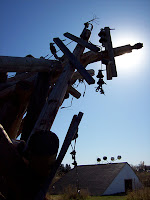As I alluded to in my last post, a few weeks ago a friend and I drove down to the Twin Cities to attend the three day Mid America Print Conference, put on by the
Mid America Print Council. This is a semi-annual event held every two years at various locations throughout the Mid West. The previous time I went was my first experience, and it was right in my backyard of Fargo. I had a blast, and couldn't wait to experience it again. On the agenda were lectures, gallery tours and openings, demonstrations, vendor's fairs, and a multitude of other print-related activities.

One of the earlier demonstrations I attended was entitled "Extreme Chine Colle" and was put on by the Highpoint Center for Printmaking, a beautiful printmaking studio located in Minneapolis. Here is Cole Rogers, Artistic Director and Master Printer at Highpoint, along with his assistant Zac Adams-Bliss attaching four large pieces of chine colle one on top of the other before placing it on a plain sheet of paper for backing support. The overlay of the chine colle pieces gave a beautiful depth and subtle variation of grays.
While I enjoyed the chine colle demo it wasn't something I could see using regularly in my work.
What really got my attention was a reductive asphaltum lithography demonstration by Michael Barnes. Similar to the "maniere noire" or "black method" used in traditional stone lithography the stone is worked reductively to create the image, either by scratching into the stone, using an abrasive, or a solvent.

The main difference is in the base, which is asphaltum thinned down with mineral spirits instead of a traditional rolled up ink base. What was extremely impressive about this method was the ease of reducing the image and printing various colors. During the relatively short demo, Mr. Barnes processed, reduced, and printed three colors in about the span of half an hour. Also impressive were the extremely soft and subtle effects he achieved.
Below is a stone he had been working on- you can see the delicacy of the marks. The faint lines over the top are just from the sponge.

In addition to the demos were various panels, like this one featuring Jack Damer (lithography teacher at Madison) and Beauvais Lyons (lithography teacher at Tennessee-Knoxville). This current discussion was about a survey conducted by Beauvais sent out to members of the MAPC, and generally covered trends in printmaking, generational differences, and teaching.

One of the last nights of the conference we took a bus tour to various galleries around the cities. About halfway through the tour we stumbled upon an opening reception featuring the work of Lloyd Menard- the originator of Frogman's Press in South Dakota. Mr. Menard was also honored with the Outstanding Printmaker award this year from the MAPC. It was a real treat to hear him talk about his process, ideas, and changing aesthetics over the years, as well as view a huge collection of his prints spanning over the last few decades.
Overall the conference was an invaluable experience, and I can hardly wait for the next one. Hopefully I'll be able to attend Southern Graphics next year, which I'm told is like this conference on steroids. Sounds like fun.
____________________________________________
So, as if the conference wasn't exciting enough, two days after returning home I had the honor of meeting and spending time with the one and only Carol Wax. That's right- the woman who literally wrote the book on mezzotint art. She was giving a three day workshop in conjunction with a symposium lecture series put on by Minnesota State University Moorhead art department. Unfortunately I don't have any images to share since she didn't care much for having her picture taken, but over those three days she talked about the history of the medium, lectured on her own work, and gave hands on demonstrations for preparing the plate and how to print it. Like the conference, it was a lot of information to take in in a few short days, but Carol seemed so excited and eager to share her knowledge that it was hard to not be excited. Plus she was just such an interesting and kind person- I feel very lucky to just have met her. :)































